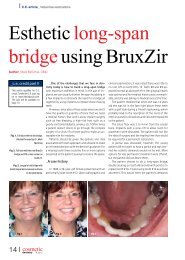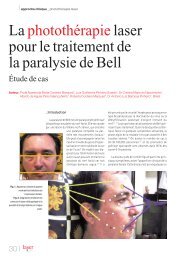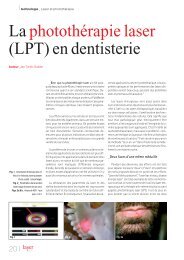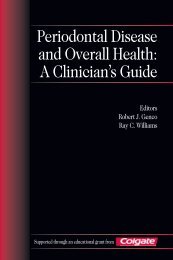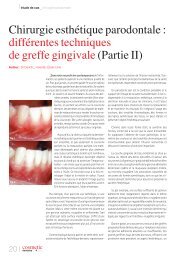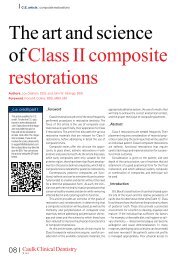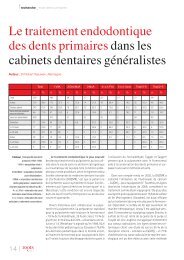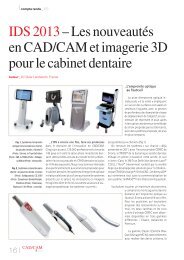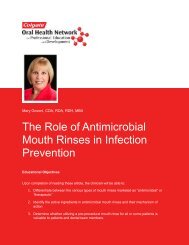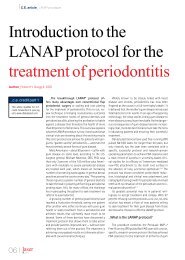Periodontal Disease and Overall Health: A Clinician's Guide
Periodontal Disease and Overall Health: A Clinician's Guide
Periodontal Disease and Overall Health: A Clinician's Guide
You also want an ePaper? Increase the reach of your titles
YUMPU automatically turns print PDFs into web optimized ePapers that Google loves.
CHAPTER 3 Infection <strong>and</strong> Inflammation 27tissue. Normally, the intact sulcular <strong>and</strong> junctionalepithelium serves as an effective naturalbarrier that keeps the bacteria from enteringhost tissues. However, severalperiodontopathogens (e.g., P. gingivalis, A.actinomycetemcomitans) have been shownto invade <strong>and</strong> transverse epithelial cells togain access to the connective tissue. Moreover,bacterial components (e.g., LPS, PGN)<strong>and</strong> products (e.g., proteases, toxins) that areeither shed or secreted can also diffusethrough the epithelial junctions to the connectivetissue. 9Bacteria in Connective TissueBacteria <strong>and</strong>/or their virulence factorsfound in the connective tissue directly stimulatehost cells residing in this area, includingleukocytes, fibroblasts, mast cells, endo -thelial cells, dendritic cells <strong>and</strong> lymphocytes.Neutrophils, macrophages, fibroblasts <strong>and</strong>mast cells release more proinflammatory cytokines(TNF-, IL-1, IL-6, IL-12), chemoattractants(IL-8, MIP-1- , MIP-2, MCP-1,MCP-5) <strong>and</strong> PGE 2in the connective tissue.In addition, degranulation of mast cells resultsin the secretion of histamine <strong>and</strong>leukotrienes further amplifying the inflammatorycascade. 10,11Mediators that are secreted from activatedhost cells (e.g., IL-1, TNF-, PGE 2,<strong>and</strong> histamine) will further assist bacterialvirulence factors in the activation of endo -thelial cells. This leads to secretion of morechemokines (IL-8, MCP-1) <strong>and</strong> expressionof adhesion molecules on the surface of endothelialcells, which are important forleukocyte extravasation (P- <strong>and</strong> E-selectinsas wells as ICAM-1 <strong>and</strong> -2). 12 Specifically,P- <strong>and</strong> E-selectins interact with glyco proteinson leukocytes allowing the cells to adhere reversiblyto the vessel wall, causing circulatingleukocytes to appear to “roll” along theactivated endothelium. Then, IL-8 <strong>and</strong> otherchemokines, bound to proteoglycans on thesurface of leukocytes, trigger a conformationalchange of integrins (LFA-1, CD11b:CD18). As a result, adhesive properties increasedramatically <strong>and</strong> leukocytes attachfirmly to ICAM-1 expressed on endothelialcells. TNF-, PGE 2<strong>and</strong> histamine increasevascular permeability, allowing leukocytesto squeeze between the endo thelial cells,thereby entering the connective tissue ina process known as diapedesis. Finally,chemokines, such as IL-8 that are producedat the site of infection <strong>and</strong> bind to proteoglycansof the extracellular matrix, alongwith bacterial chemo-attractants (fMLP,fimbriae) form a concentration gradient thatguides the leukocytes to migrate to the focusof infection.The Inflammatory CascadeNeutrophils are the first leukocytes toarrive followed by mononuclear phagocytesthat subsequently differentiate into macro -phages. The interaction of these cells withbacterial virulence factors induces further activation,which enhances their phagocytic activityby increasing the production of nitricoxide (NO) <strong>and</strong> the expression of complementreceptors (CR3). If the innate immuneresponse is successful, the bacteria are eliminated<strong>and</strong> resolution of inflammation follows.However, persistence of bacteria leadsto a chronic response characterized by extracelluarrelease of neutrophil granule contents,including degradative enzymes <strong>and</strong> reactiveoxygen species that spill into the extracellularmilieu, leading to local tissue damage <strong>and</strong>amplification of acute inflammatory signals. 13Pro-inflammatory cytokines (TNF-,IL-1, IL-6) from the site of inflammationenter the circulation <strong>and</strong> reach the liverwhere they activate hepatocytes. This leads,among other events, to the synthesis ofplasma proteins known as acute-phase proteins,including LPS binding protein (LBP)<strong>and</strong> CD14, which are important for therecognition of bacterial virulence factors.Complement proteins <strong>and</strong> C-reactive protein



